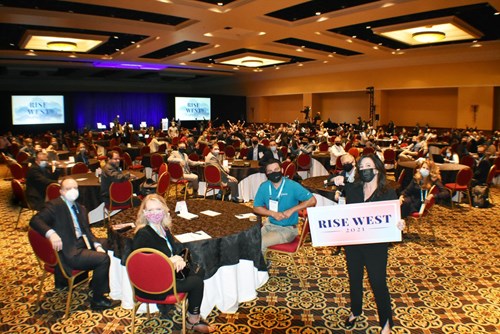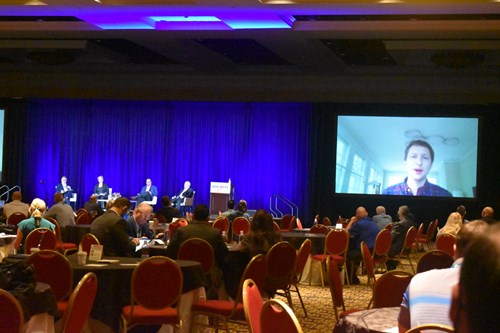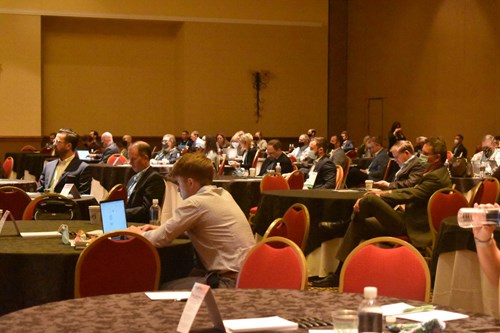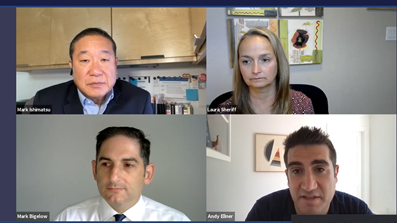Our 2021 hybrid event kicked off on Wednesday with 400 attendees gathering in-person at The Broadmoor in Colorado Springs, while 200 others participated in the event via their home offices.

In her opening remarks, Ana Handshuh, CHC, Principal, CAT5 Strategies, and chair of RISE’s Quality & Revenue Community, urged attendees to make the most of the networking and learning opportunities at the conference.
“This has been a challenging yet very exciting time for all of us in the health care industry. People are reprioritizing their expectations, not only us, but our enrollees, our patients. They are taking a look at what is important to them,” she said, noting that she has a sense from talking to attendees at the conference that they are aiming to innovate to better serve their members and do something that is greater than themselves.
Here is just a sample of the things we learned during the first day of the main conference:
1. Our health is the backbone to our accomplishments
World-renowned performance psychologist Jim Loehr, Ed.D., co-founder of Johnson & Johnson Human Performance Institute, delivered an inspiring and introspective keynote address this morning where he offered takeaways from his 30-plus years of applied research and training of elite performers from diverse arenas, including Olympic gold medalists, military Special Forces, hostage rescue teams, surgeons, and Fortune 500 CEOs to achieve sustained high performance.
He’s worked with some of the greatest talent and brightest minds, but the pillar to performance always came back to health for Dr. Loehr. “We can’t do much if we don’t have health,” he said. It was one of many life-lessons he would gain through his work.

Throughout the thought-provoking presentation, Dr. Loehr shared the biggest career insights he realized over the years. Among them:
Our health ignites our performance. To become a performer in any area of our life–whether it’s at work, in school, or as a mother or father–we must be healthy physically, emotionally, mentally, and spiritually, according to Dr. Loehr.
Purpose is the centerpiece of everyone’s life. When you understand your true purpose, everything else falls into place. And the more your purpose is “self-transcending” and has less to do with you and more about those around you, something magical happens, he said. “You open that vault, and you dig deeper than you ever would have done had it been for your own self-preservation or needs.”
There’s a hidden scorecard in life. Have you ever thought about the legacy you wish to leave behind? Or what you hope to be remembered for? That’s our hidden scorecard, and it’s a great indication of where to put our emphasis and energy in present time, explained Dr. Loehr.
Who we are as persons is far more important than who we are as performers. The person you’re becoming along the chase as a performer is more important on the priority list than the performance itself, said Dr. Loehr. “There is what you achieved, and there is how you got there. What price are you paying to get to the top of the mountain?”
Energy investment spawns life. It’s not the time you invest in something that makes the difference but your energy.
Stress exposure is the stimulus for all growth, and recovery is when growth occurs. Stress isn’t the bad guy in life, said Dr. Loehr, rather the insufficient recovery from stress physically, emotionally, mentally, and spiritually is the true culprit.
Our story is our destiny. We can change our story and our destiny at any time, noted Dr. Loehr. But first, you must unearth the story that failed to get the job done to gain a new mindset, commitment, sense of purpose, and understanding.
Full engagement is our greatest gift to the world. We breathe life into wherever we invest our energy, so be intentional about where you wish to have an impact and step into that space with full engagement, said Dr. Loehr.
Our inner voice is the most important coach we will ever have in our lives. It’s important to speak to ourselves the way we would speak to someone we dearly care about, for our private voice is the “master storyteller” of our life, noted Dr. Loehr.
Mental toughness is not just mental. It’s physical, emotional, mental, and spiritual, and you have to work each area, advised Dr. Loehr.
2. Expect the Biden administration and the Democratic-controlled House and Senate to get several health-related priorities passed under budget reconciliation
During a panel discussion on the Biden Administration’s Impact on Managed Care, Marc Goldwein, senior vice president and senior policy director, Committee for a Responsible Federal Budget, provided an overview on the Democrats’ proposed spending plan and the administration’s overall policy for health care. Among the priorities: the response to COVID-19 including boosting vaccinations and stopping the spread of the virus; expanding insurance and benefits; and lowering health care costs.

How much of those goals will be addressed in the proposed $3.5 trillion spending plan remains to be seen, but Goldwein said that lawmakers are discussing extending one-time expansion of Affordable Care Act subsidies, closing Medicaid coverage gaps, extending long-term care benefits, expanding Medicare by dropping the eligibility age to 60, and expanding benefits for the elderly and disabled, including adding a dental, vision, and hearing component to Medicare; and allowing Medicare to negotiate drug prices for public and private plans. There is also some talk of provider payment reform, especially among those who believe Medicare Advantage plans are overpaid.
“The last issue,” he said, “is the solvency of the Medicare Trust Fund.” Yesterday the Medicare Trustee board issued a new report that the Medicare’s insurance trust fund that pays hospital will run out in 2026. This issue will loom large over the next four to five years he said.
Goldwein said that in the short-term the administration is focused on the budget reconciliation package and will fast track the opportunity to pass the $3.5 trillion legislation, which will only need 50 votes to pass. But that package will include spending on education, climate change, child care, tax credits, as well as health care. “Policy makers are having three fights. How are we going to spend, how are we going to divvy up that spending between health care and non-healthcare, and within healthcare, where are we going to divvy it up,” he said.
Although some lawmakers are hoping to get the budget passed next month, Goldwein predicted it will likely take place in two or three months.
3. Patient care, member engagement, and provider support continue to be focus areas for health plans as the pandemic continues
During a discussion on the current and future state of risk adjustment and Star ratings, panelists opened up about the challenges they faced with COVID-19, member engagement, provider burnout, and the strategies they used to mitigate them.

One of the biggest challenges: Forecasting and making assumptions last year without any historical data. This year plans will have to see how their assumptions played out, said Elaine Taverna, senior vice president risk adjustment and quality, Advantasure. “You couldn’t even retrospectively look back at what happened and make assumptions on a national basis. It was different region by region. The COVID experience was unique, which meant you had to have a good ability to track and monitor what was happening.”
Early on in the pandemic, Rick Liu, vice president, risk adjustment, SCAN Health Plan, said he saw provider visit rates dropped 50 percent within his network. “We knew we had to do something and figure out how long that would be, how many waves we were going to have, a lot of guesswork. And now we are trying to figure out how close that was,” he said.
CDPHP® launched a campaign for patients and providers called “Don’t Delay Care” that they promoted on all available channels, explained Renée Golderman, senior vice president, chief quality officer. The campaign focused on encouraging members to not be afraid to seek care and to call their provider to discuss the safest options including visits by telephone, telehealth, and if necessary, in-person. Some providers even saw patients in parking lots, she said.
As important as membership engagement was and ensuring that members received the care they needed, panelists said they also focused on the needs of their networks of providers.
“We are all hearing what our health workers are going through the last two years,” Taverna said. “We are hearing of an exodus nationally of the labor force because of what they have gone through, and they don’t want to go through it again.”
One way to connect with your providers, Golderman said, is partnering with them on key quality metrics and capturing conditions. “Doctors want good clinical outcomes for their patients,” she said, noting that her plan collaborated with providers to obtain the best outcomes for patients and structuring a capitated risk agreement. “Our physician network embraced that,” she said.
Liu said SCAN Health didn’t aggressively pursue chronic condition management, HCCs, and risk adjustment in the early months of the pandemic so providers could focus on patient care. “We had to understand there were priorities that the providers groups had to do. We knew there would be tradeoffs we were going to have to deal with and project out, but one thing we started to do was back off. We really needed the country to deal with the pandemic first and foremost and give providers the space to handle that. We continued programs, but tried not to be as aggressive,” he said. “It was really recognition and letting the doctors deal with the situation at hand.”
The panel said this year’s focus areas will include new members and provider encounters, utilization data to better understand unrecognized chronic conditions needs, expansion of in-home assessment programs and telehealth, support of primary care providers and wrap-around programs, seek out opportunities for risk-adjustable chronic condition capture, and get access to EMR data to ramp up for retrospective coding.
4. Aligned efficiency efforts forge provider/payer collaboration
During the provider engagement track, providers shared their transparent perspectives on the keys to provider/payer collaboration in a post-pandemic world. Throughout the session, panelists engaged in open dialogue around what’s working well within their organizations, the practices they find effective in reducing barriers, and the pain points they still run into while collaborating with payers.

While examining the stand-out activities that contribute to their organizations’ success, the panel shared an inside look at their unique approaches. Some of the most effective activities shared included a senior health services program led by a team of advanced practice providers to help facilitate coding gaps, quality gaps, and assist in the completion of annual wellness visits; a digital care center that encompasses a centralized call center as well as a clinical contact center to provide remote patient monitoring, outreach to schedule visits, and documentation for annual wellness; and incentive programs for support staff to provide quality patient care as well as comprehensive office performance.
When it comes to providers being increasingly asked to carry out administrative work related to risk adjustment and quality value-based care in general, the panelists shared a couple tactics that they have found successful, such as the roll-out of online appointment scheduling, PA patient calls to complete all pre-visit documentation for annual visits, the utilization of best practice advisory alerts through an EMR, and provider coaches in select care settings to not only provide care but serve as educators.
The panel also highlighted the importance in providing an educational platform to physicians in areas including accurate coding, coding opportunities, and standardized documentation.
Education for the support staff is just as important, noted panel speaker Jennifer Ross, director of risk adjustment, compliance programs, Aegis Medical Group.
“Having your support staff understand the business model—and unfortunately in health care, now it is a business model—the business model that you have is extremely important,” said Ross, noting Aegis Medical Group has also implemented an incentive program for support staff that has been extremely successful in enhancing office performance.
5. Telehealth is here to stay and may reinvent health care as we know it
COVID-19 forced health care organizations to quickly adapt and take advantage of telemedicine platforms to continue to care for patients. But will the industry continue to embrace the technology post-pandemic? Yes, and it may completely change the way we practice medicine, according to panelists who discussed the current successes and future of telehealth.

The discussion, led by Moderator Mark Bigelow, vice president, EXL, explored the challenges health payers faced when pivoting to telehealth, the successes they had reaching Medicare populations, and strategies for training physicians on how to properly use the platform and document the care provided for billing purposes. Among the panel’s suggestions:
Segment populations most likely to benefit from telehealth visits: Risk Adjustment Specialist and Consultant Laura Sheriff said during the initial shift to telehealth she focused on scheduling follow-up visits for members who were recently discharged from the hospital. The other population she focused on was behavioral health patients, who in many instances felt more comfortable meeting practitioners from their homes.
Create “telehealth cheat sheets” for providers: Sheriff said she created these training sheets to help providers learn how to properly bill for services and make sure they noted in their documentation that they conducted a telehealth visit with audio and visual components.
Collect more member data for demographic profiles: Mark Ishimatsu,
director of enterprise risk adjustment, L.A. Care, said the plan widened its targeting efforts during the pandemic because of a drop in general in-person encounters. Part of those efforts are using in-person home assessments to collect elements for demographic profiles to determine how they want to connect with providers and what type of technologies they are comfortable using.
Take advantage of the platform’s ability to ease access to care: COVID revealed the inequities of access to care, Ishimatsu said. The introduction of newer technologies opens opportunities to think about different models of care delivery.
Expect telehealth to reinvent traditional primary care: Andy Ellner, M.D., founder, Firefly Health, a virtual primary care practice established in 2016, said he expects more primary care practices may move away from in-person visits to a virtual platform like the one Firefly built. He believes many people, particularly the Medicare and Medicare Advantage population, have difficulty coming to a clinic to meet with providers in person and there are technology-enabled applications they can use for better care management.
